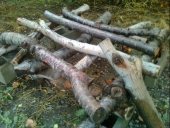Hi Andrew,
So there are two main types of mycorrhizal fungi (well, 7 really): arbuscular mycorrhizae (AM), which do not form mushrooms, and ectomycorrhzial fungi (ECM), which form mushrooms and truffles.
AM are generalists that associate with 90-95% of all plants in the world. There are around 169 species, though those in the genus Glomus are the easiest to cultivate. They have a huge ecological and economic importance and their relationship with plants is the most studied plant symbiosis, hands down. The Rodale institute worked with the USDA to develop
this protocol for cultivating local mycorrhizal fungi (ideal) or amplifying commercial inoculum, such
as this.
Most ECM fungi (esp. the gourmets like Chanterelles and Boletes, etc) form intimate relationships with other soil biota that are required for their fruiting. Thus sprinkling their spore mass along with some local
compost tea is a good start. However, if you just want to inoculate trees with ECM (a standard silviculture practice) so that the trees establish, species in the genera Pisolithus, Rhizopogon, Laccaria, and Scleroderma are easy to cultivate. Species in Laccaria produce edible and medicinal mushrooms. The commerical product linked contains spores of these genera along with AM species.
Mycorrhizal fungi do decompose things, but their are not the heavy hitting wood decomposers. Thats a very different niche.
Mycorrhizal fungi do not grow in compost tea, though other soil fungi (such as yeasts and molds) may.






